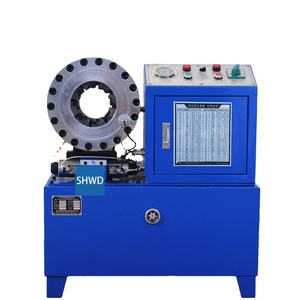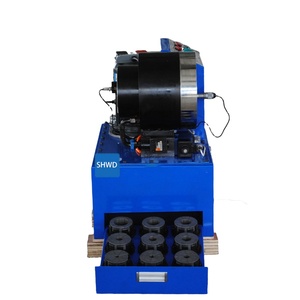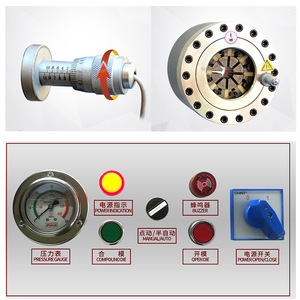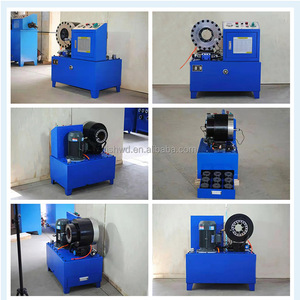
All categories
Featured selections
Trade Assurance
Buyer Central
Help Center
Get the app
Become a supplier

(720 products available)




















































Hydrostatic pressure pipe test machines are engineered to check pipes’ pressure fortitude. By identifying weak parts, these tests help avert future mishaps.
The human-based control of pressure application is made possible by a Manual Hydrostatic Testing Machine. It is employed for small-scale pipeline testing. These machines are usually used in small projects or remote areas. Their low cost makes them popular when tight budgets constrain projects. Despite its size, the manual process is labour-intensive. Note that larger, high-traffic pipeline structures are not suited for this testing process. Manual machines are portable due to their small size and are usually kept in trucks for mobility.
An Electric Hydrostatic Testing Machine substitutes manual pressure adjustments with an electric pump. This modification grants quicker and more consistent testing results. Operators find it simple to manage, making it a viable option for medium to large projects. A computer controls most recent electric models. This model reduces human errors and simplifies the testing process.
High-pressure machines have been developed for rigorous demands. They test large-diameter pipelines that require stringent pressure checks. The equipment efficiently manages significant workloads. However, they come with high costs, requiring expert operation and maintenance. Machine costs and repairs could significantly affect budgets for smaller projects. These advanced devices are often required in large construction projects. Their effectiveness outweighs the disadvantages in demanding hydrotesting conditions.
Manual and electric machines both do the same job but have some differences. People who work on small jobs like using manual machines because they are cheap and can be carried around. But for bigger jobs, people choose electric machines because they are faster and easier to control. Even if electric machines cost more, they give contractors better work results, so optional projects like large heating cooling jobs will always choose them. And since each kind works well for small or big jobs, picking the right one depends on the work at hand.
The hydrotest machines must endure the demanding task of pumping liquids into pipes under immense pressure. Choose machine materials wisely based on the project's environment, liquid types, and temperature ranges.
Water, oil, and corrosive chemicals make up the most common fluids in pipes. Hence, machines must resist this corrosion. Since they are immune to rust, stainless steel machines are ideal. Stainless steel handles acidic liquids commonly found in chemical plants. Despite being more expensive, their strength results in fewer repairs. This durability is beneficial in preventing work delays. So, these steels are chosen when having reliable tests in tough conditions is important.
If a project requires light machines, aluminium alloy could be the best choice. Though aluminium is not as tough as stainless steel, it still handles water or simple oils well. Aluminium machines are simply used in small tasks or where machines need to be carried. The alloy form of aluminium reinforces the metal, giving it extra toughness. While not as strong, the metal is lightweight and easier to carry.
Cast iron withstands high pressures and has low production costs. However, it may not handle corrosive fluids as well as other choices. Even so, if testing requires handling simple liquids with no chemicals, cast iron is often used. Also, large-scale operations value the material's cost savings.
Brass is a resilient alloy of copper and zinc capable of withstanding significant pressures. People often use it in machines dealing with water or diverse oils. Although not widely chosen for tough conditions, it performs sufficiently in less demanding tasks. Its immunity enables it to work many times without degrading. Hence, it is useful for projects that require continuous testing without frequently changing the device.
Several sectors and job conditions need these test devices for durable pipes. There are frequent places and uses for the hydrostatic testing tools.
Utility companies have the frequent need to check pipes used in drinking water lines. Be it a municipal project or a rural installation, the machines ensure pipes resist required pressures without leaking. They perform crucial post-installation tests before pipelines deliver water. Regular testing maintains systems used for decades. Retrofit projects also need tests to satisfy modern pressure requirements.
Pipeline tests guarantee that oil and gas pipes endure extreme pressures safely. Machines do vital stress testing after construction and before a pipeline activates. They locate weak points in large systems over enormous distances. Maintenance crews use tests to avoid breakdowns during routine inspections. They are key in valuing pipeline integrity in corrosive environments like deep drilling. Quick identification of failures keeps workers safe and saves money.
Factories and buildings test heating, cooling, and other fluid lines to verify installation quality. Machines ensure internal pressure tolerances for system longevity. They prevent costly downtime or structural damage from undetected leaks. Frequent tests identify weak spots for early repair. Machines help builders and manufacturers proactively maintain safety standards and worry-free operations. No one wants a burst AC or heating line.
Pipes and pumps on ships and submarines work under tremendous pressure. So, testing machines validate the strength and safety of these critical systems. They check if naval vessels safely endure rough ocean conditions. Machines identify weak metal or improper welding before launch. Shipbuilders rely on them to ensure vessels perform without disaster at sea.
Spaceships and planes contain fluid transfer systems subjected to huge pressure changes. So, machines verify components' safety and reliability during flight. They ensure no fuel lines rupture from altitude variations. Test failure catches problems, reducing crashes. The aerospace sector depends on these hydrostatic testers, as fatigued components easily risk many lives.
These pipe test machines have specifications that suit every work need. They have common features that help operate them effectively in any situation.
Hydrostatic testers handle pressures from 0 to over 10,000 psi. Higher ranges are for oil and chemical pipes. Small jobs, like home heating, require just a few hundred. Choose a model within the right range for tasks. Too low a pressure risks damage. Too high doesn't improve anything.
The flow rate, indicated in gallons per minute (GPM), relates to pipe size. It should match the diameter. A large GPM applies tests to big pipes quickly. Small GPM works for narrow pipes where speed isn't needed. However, machines should not run long without cooling.
Water treats as the simplest and least risky fluid for testing pipes. Machines also handle chemical fluids in manufacturing or treatment plants. Yet, not all machines tolerate all fluids. It is important to check that all fluids pass through the machine without damaging it.
Electric models power through outlets for seamless work. Manual types power by hand. Petrol or diesel versions run on fuel. Decide what is most accessible. Electric works best indoors. Fuel runs outside where exhaust can escape.
The inner portions tolerating pressure must be tough. Stainless steel treats chemicals safely. Steel protects against corrosion and wear. Cast iron is strong and affordable, but it does not last in harsh environments like chemicals. Brass offers corrosion protection in smaller jobs. Choose the right material so the device lasts through tasks.
Selecting the right pipe test machine for each project is critical. Several factors, including a project's size, the pipe type, and the environment, should be considered. These aspects dictate which machine will perform the best.
Project scale matters. For small jobs, a portable manual machine may be sufficient. However, larger or high-volume projects demand an automated or electric model. These machines handle wider pipes and perform frequent tests. They maintain efficiency and accuracy in massive projects.
Next, consider the pipe's material. An electric testing machine is best if the project involves PVC or HDPE pipes. They maintain a consistent pressure without damaging delicate plastics. A hydraulic machine is necessary if the pipes are steel. Steel needs a machine that produces high pressure without giving way.
The fluid environment in the pipes also impacts the machine choice. If the pipes carry chemicals, choose a machine with resistant materials like stainless steel or brass. Chemicals may degrade weaker metals. It could disable the machine, leading to project delays. So, select materials that withstand the fluid environment.
Finally, evaluate the workforce's skill level. While electric machines are simple to control, skilled workers are required for manual machines. If the operation is large or multiple shifts, require an automatic system. This feature makes tests faster, too, with no human errors. A machine suited to specific project needs reduces breakdowns and delays. So, fully grasp the project's requirements before selecting which machine to use. It ensures maximum performance on every task.
A1: These machines help test pipes in large work areas that handle heating, cooling, or fluid transfer.
A2: Yes, as long as the machine's metals resist the chemicals in the surrounding environment.
A3: Strong metals like steel or brass work best in this situation. They will not warp or bend like weaker metals.
A4: These machines last from 5 to 10 years, depending on how much strain they experience and how well they are taken care of.